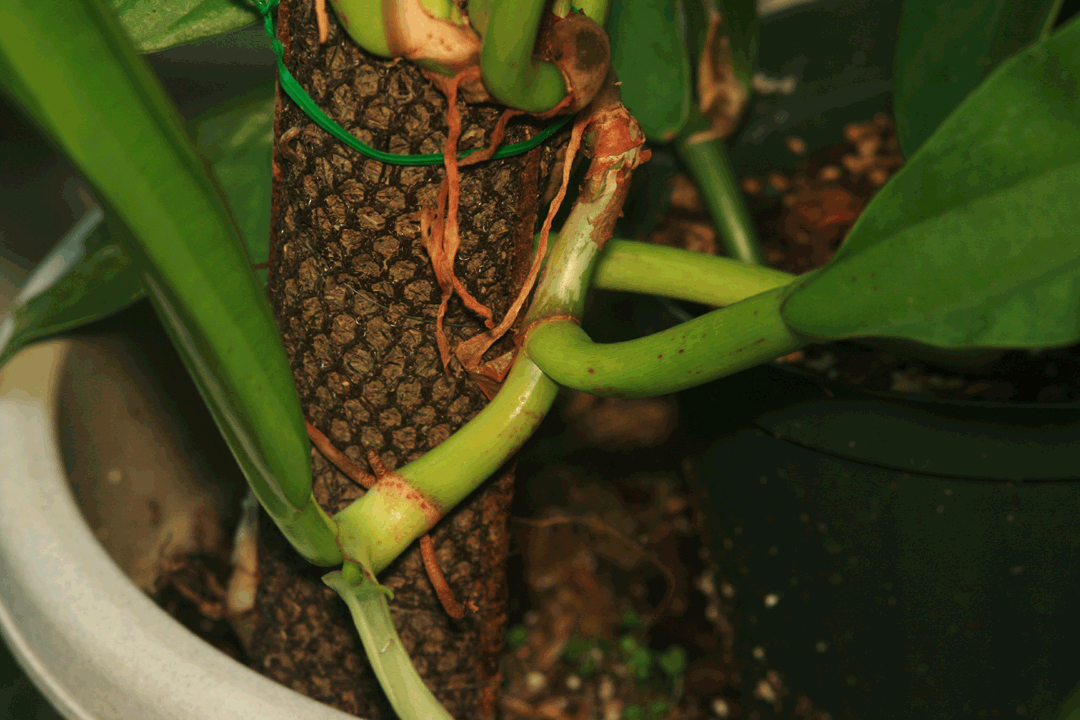![]()
Aroids and other genera in the Collection
Take the Tour Now?
Orchids
The
Exotic Rainforest
Plants in
the Exotic Rainforest Collection
Images on this website are copyright protected. Please contact us before any reuse.
Philodendron crassinervium
Lindl.
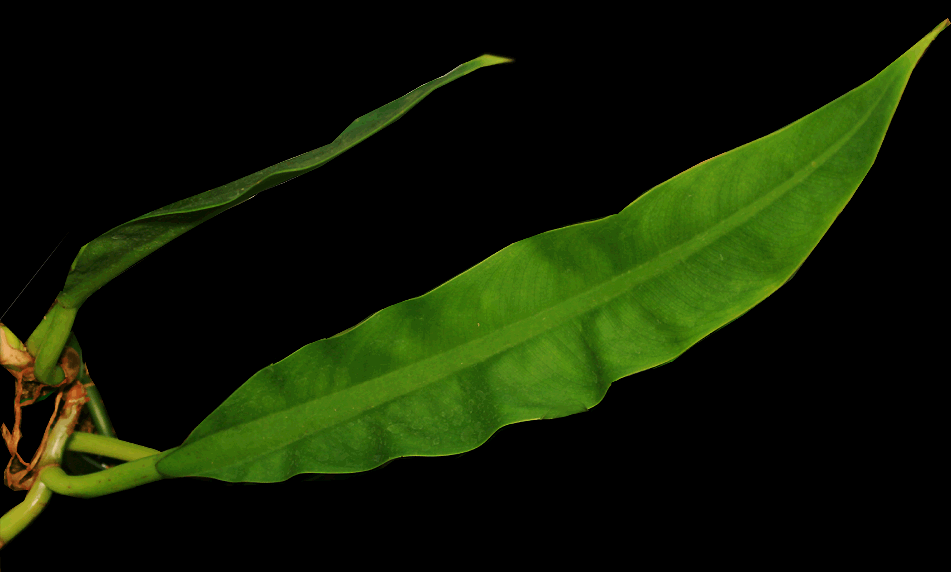
Philodendron crassinervium
Lindl.
Synonyms:
Philodendron lanceolatum
(Vell.)
Schott
Philodendron alternans Schott
Latin: Crassus (crassi)=
thick or plump
Nervis (nervium)=
nerve
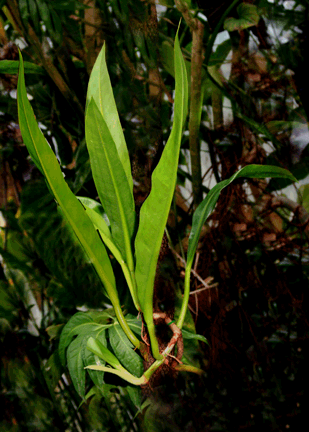 Philodendron crassinervium
(cras-SEE-nervium)
was described to science by English botanist John Lindley (February 8,1799
to November 1, 1865). The species was published to science in 1837 and
is considered relatively abundant in its natural habitat. Philodendron crassinervium
is exclusively found (endemic) in the southeastern portion of Brazil at elevations of 100 to 1,250 meters
(935 to 4,100 feet) above sea level. It occurs in Brazil's restinga
forest
near
the Atlantic Ocean often close to the beach.
The restinga is a unique coastal tropical and subtropical moist rain
forest that includes the coastal sand plains along Brazil's southeastern
coastline.
Philodendron crassinervium
(cras-SEE-nervium)
was described to science by English botanist John Lindley (February 8,1799
to November 1, 1865). The species was published to science in 1837 and
is considered relatively abundant in its natural habitat. Philodendron crassinervium
is exclusively found (endemic) in the southeastern portion of Brazil at elevations of 100 to 1,250 meters
(935 to 4,100 feet) above sea level. It occurs in Brazil's restinga
forest
near
the Atlantic Ocean often close to the beach.
The restinga is a unique coastal tropical and subtropical moist rain
forest that includes the coastal sand plains along Brazil's southeastern
coastline.
The distribution of the species is from the state of Minas Gerais north of Rio de Janeiro
state to Santa Catarina
in the southern coastal Brazilian state
of Santa Catarina (SE-ta
ka-ta-Rin-na) which is south of
São Paulo.
The state of Santa Catarina has one of the highest standards of living in
the country.
Many unusual Philodendron
species have been discovered in this portion of Brazil.
There is also a village of
Santa Catarina in the northeastern portion of Brazil but these are different
locations many kilometers (miles) apart.
When attempting to identify any species the specific characteristics of the specimen being researched are important. One goal of this article is to attempt to explain and illustrate the
distinguishing characteristics of Philodendron crassinervium in a way any collector can use to verify whether or not a plant
is or is not the species. Although scientific terminology is
used we attempt to explain each term so the reader may find this
article both explanative and educational.
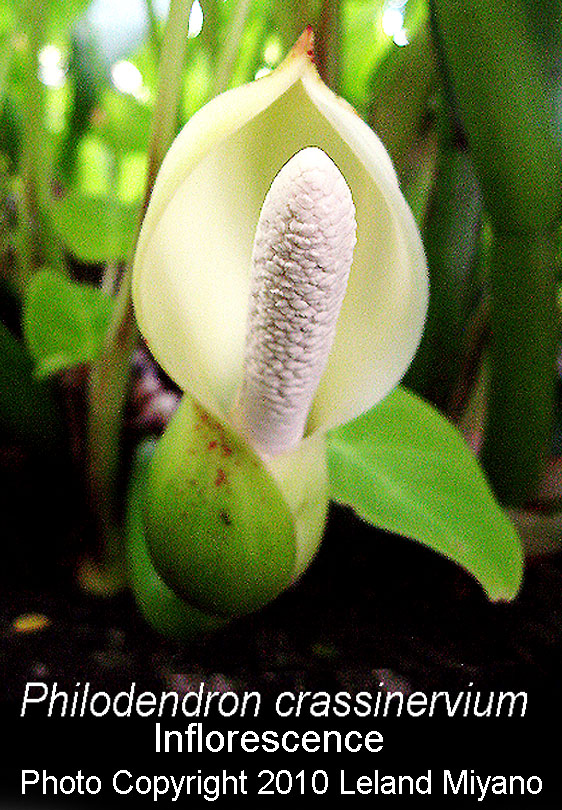
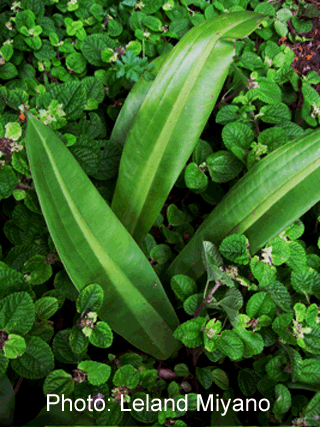 The genus
Philodendron is divided into three subgenera which include
subgenus Philodendron, subgenus Meconostigma and subgenus
Pteromischum. Those subgenera are then further divided into sections and
subsections based on the individual characteristics of the plant.
The genus
Philodendron is divided into three subgenera which include
subgenus Philodendron, subgenus Meconostigma and subgenus
Pteromischum. Those subgenera are then further divided into sections and
subsections based on the individual characteristics of the plant.
Philodendron crassinervium is placed in subgenus Philodendron section Baursia. Section Baursia includes species with inconspicuous primary lateral leaf veins as well as other specific characteristics. Members of the section are highly variable in regards to the sexual features of the inflorescence as well as the species' leaf shape and the habitat in which it grows. German botanists Heinrich Gustav Adolf Engler (1844–1930) and Johann Wilhelm (Kurt) Krause (1883-1963) defined section Baursia. Krause began working with Engler at the Berlin Botanical Garden on January 1, 1905. As defined by Engler and Krause Philodendron crassinervium is the type of section Baursia. A "type" is the original specimen considered and described.
At present there are 33 species
included in section Baursia. All of the species included are
supposedly devoid
of primary
lateral veins but in reality this is not true of all the species
included in the group. Most species have elongated simple leaf blades but there
are three species included which have tri-lobed or tripartite blades.
A tripartite blade is divided into three parts. The species which best
fit the description for section Baursia occur primarily in
the eastern portion of South America or in
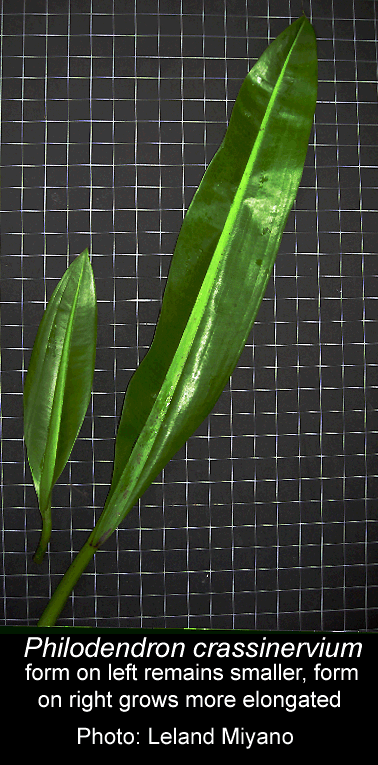 the upper Amazon basin.
All have roughly
oblong or oblong-elliptic leaf blades and many (but not
all) possess indistinct and somewhat difficult to observe primary lateral leaf veins.
the upper Amazon basin.
All have roughly
oblong or oblong-elliptic leaf blades and many (but not
all) possess indistinct and somewhat difficult to observe primary lateral leaf veins.
One important
consideration is the fact Philodendron crassinervium is a variable
species and does not always maintain the same leaf shape or size.
Philodendron crassinervium
grows in a variety of habitats including as a lithophyte growing on stone. However,
there is some debate as to whether the plants now considered
synonyms are or are not unique species.
Based on personal communication with aroid botanist Dr. Simon Mayo of the Royal Botanic Garden Kew in London the synonym Philodendron lanceolatum Schott (lan-SEE-o-la-tum) which was published in 1856 is based on a Brazilian plant drawn on a plate by J. M. C. Vellozo. A synonym is a name published and granted scientifically to a species already known to science. As a result, Philodendron lanceolatum is currently treated as a synonym of Philodendron crassinervium. In this case Philodendron crassinervium is the accepted species name since it was published prior to any other names used for the same plant species.
The sometimes elongated leaf blades of the synonym Philodendron lanceolatum are likely the reason the long bladed specimen was described as a new species when in fact it is likely a naturally occurring variation of Philodendron crassinervium (see photo, right. Not all specimens of Philodendron crassinervium exhibit extremely elongated blades. Each square indicates 2.54 cm (one square inch).
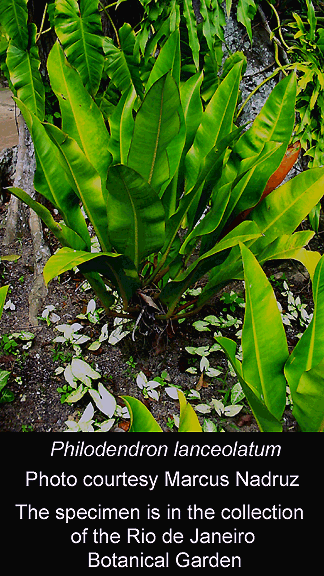 When I asked aroid botanist Marcus A. Nadruz Coelho, Diretoria de Pesquisas, Instituto de
Pesquisas Jardim Botanico do Rio de Janeiro (Rio
de Janeiro Botanical Garden)
in Brazil about Philodendron lanceolatum he responded,
"Referring
to the publications of Velozo and Schott, P. lanceolatum is a Brazilian
species, synonym of P. crassinervium. However, in the living collection of
Croat I had noticed that a species with the name of P. lanceolatum that was
probably collected in Bolivia. I am sending a photo of this species.
This species I have grown here in the Botanical Gardens. I believe
that P. lanceolatum is in fact a synonym of P. crassinervium."
When I asked aroid botanist Marcus A. Nadruz Coelho, Diretoria de Pesquisas, Instituto de
Pesquisas Jardim Botanico do Rio de Janeiro (Rio
de Janeiro Botanical Garden)
in Brazil about Philodendron lanceolatum he responded,
"Referring
to the publications of Velozo and Schott, P. lanceolatum is a Brazilian
species, synonym of P. crassinervium. However, in the living collection of
Croat I had noticed that a species with the name of P. lanceolatum that was
probably collected in Bolivia. I am sending a photo of this species.
This species I have grown here in the Botanical Gardens. I believe
that P. lanceolatum is in fact a synonym of P. crassinervium."
From the notes of Dr. Tom Croat found on TROPICOS he describes the inflorescence of Philodendron lanceolatum as as follows: "inflorescence solitary; peduncle green heavily tinged violet purple toward apex, distinctly demarcated from spathe 15 cm long, 7 mm diameter; spathe yellow green on tube, tinged purple violet on blade," Please note the reddish spathe in Marcus' photo of Philodendron lanceolatum to the right.
At the same time, the description of the inflorescence of Philodendron crassinervium found on CATE Araceae reads: "Spathe boat-shaped, apex shortly apiculate, tube 3-4 cm long, externally green, internally at the base light purple, green-coloured towards the spathe-blade; spadix shortly stipitate," Stipitate indicates the flower bearing spadix is found at the end of a stipe where there is a bare portion of stalk below the flowers and above the spathe.
There is another pendent (hanging leaf) form that is also considered a synonym of Philodendron crassinervium. That species was also published in 1856 as Philodendron alternans Schott (all-TER-nans). Austrian botanist Heinrich Wilhelm Schott (January 7, 1794 to March 5, 1865) described both this species and Philodendron lanceolatum. The Royal Botanic Garden Kew, London website World Checklist of Selected Plant Families confirms Philodendron alternans is a synonym and Dr. Croat also confirmed in a personal communication on August 12, 2009 the two are considered one and the same in botanical science. Philodendron alternans principally grows as an epiphyte (ep-a-FITE) but is sometimes found in the soil since the plant has fallen from a tree. As you read this article you will see new photos of the inflorescence of a plant owned by Leland Miyano in Hawaii that has produced a very distinctive inflorescence that has caused this author to wonder if in fact Philodendron alternans and Philodendron crassinervium are one and the same. When Leland provided photos of the inflorescences of both of his plants he posed this question, "My Philodendron crassinervium have bloomed and it matches the original descriptions perfectly. This species, and Philodendron alternans, have remote relationships, in my opinion...based on the morphology of the inflorescences. So...what are we dealing with?"
In addition to the confusion among growers over whether or not Philodendron crassinervium, Philodendron alternans and Philodendron lanceolatum are all the same species, please look carefully at the inflorescences of the three inflorescences show on this page. The primary difference in P. alternans and P. lanceolatum at least appears to be the interior of Philodendron alternans is primarily white with a reddish throat while that of Philodendron lanceolatum in Marcus Nadruz' photo is almost entirely purplish-red.
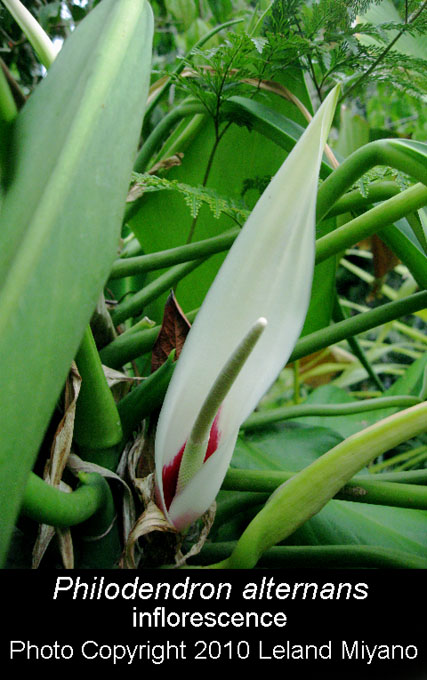
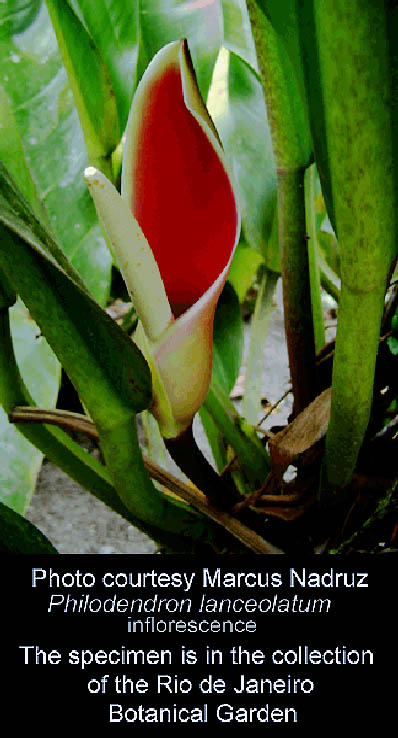
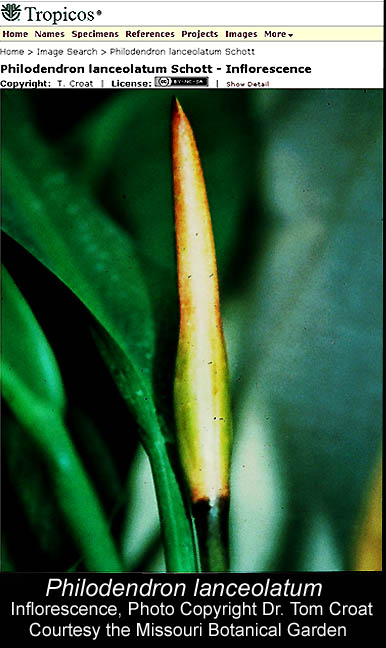
There is some difference of opinion on Philodendron alternans since
in a communication from botanist Dr. Eduardo G. Gonçalves received on
September 28, 2008 he wrote, "I do believe that P. alternans and P. crassinervium are somewhat
different species and I have both growing side by side. Philodendron
crassinervium usually is a low climber (usually terrestrial) and its
leaves are usually erect, whereas P. alternans is always hemiepiphitic
and have leaves with apices turned upright. Both
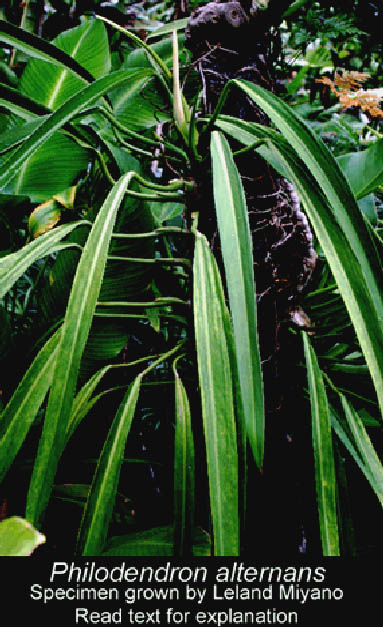 are strap-like, but P.
alternans is much more strap like. It is possible that both will prove
to be the same thing in near future, but I still think they are
different."
are strap-like, but P.
alternans is much more strap like. It is possible that both will prove
to be the same thing in near future, but I still think they are
different."
Dr. Gonçalves posted this note regarding a visit to the rare aroid collection of Roberto Burle-Marx in Brazil, "I am just back from a visit to the Burle-Marx collection at Rio de Janeiro, and I think I should share my impressions with all of you. For those that don't know him, Roberto Burle-Marx was a Brazilian architect and painter, but he is mainly know for the gardens and landscapes he created, usually using lots of aroids. His collection of plants (approximately 400 spp. of Aroids!!!!) is really impressive, mainly if you consider that most climbing Philodendron (and other climbing genera) are towering up to 4 m high and flowering like crazy. If you have never seen Dieffenbachias with stems measuring 20cm diam. (and up to 2 m high), you probably will be shocked up there! I could count 29 different aroid genera growing there, including mature plants of Heteropsis! The main group represented in his collection is Philodendron, including very rare plants like P. alternans and P. distantilobum."
Once again on July 6, 2010 Dr.
Gonçalves wrote in a private email,
"In fact, P. alternans is quite different from P. crassinervium.
Philodendron crassinervium is quite common in sparse bushes on beach sand
(restingas), usually as a low climber. It is also common in rocks and
trunks, never too far from the sea. In fact, I have seen them climbing in
rocks over the seawater, usually having root tips burnt by the salt. I have
never seen P. alternans in the wild but herbarium labels indicate that it
grows more to the country, sometimes in higher altitudes."
The restinga is a unique coastal tropical and subtropical moist rain
forest habitat and includes the coastal sand plains along the southeastern
Atlantic coastline of Brazil.
Marcus Nadruz appears to concur,
"I believe the two are distinct
species. P. crassinervium usually occurs in Atlantic forest,
close
to the beach and in the restinga forest and has a very thick
midrib.
The
leaf is bright green and has the habit of being epilithic and hemiepiphytic. P. alternans occurs in Atlantic forest far from the
sea, has
a
fine midrib, the green leaf is opaque and has an hemiepiphytic
habit. It
is endemic in Rio de Janeiro."
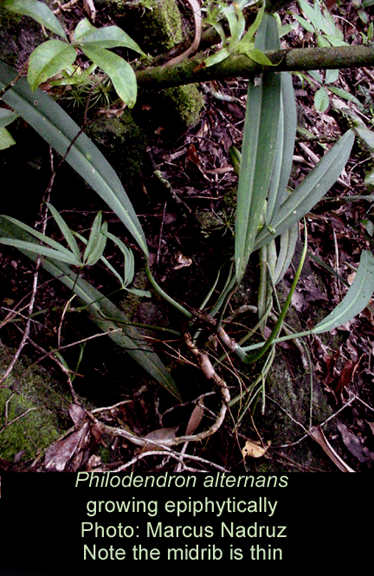 In a separate note he wrote,
"I
collected two species here in Rio de Janeiro. Philodendron
alternans does not occur in areas near the sea but in forests up to 500
meters.
Graziela Barroso (1957) cited the species in a publication as distinct from
P. crassinervium and P. longilaminatum.
The publication is: Araceae Novae. Arquivos do Jardim Botânico do Rio de
Janeiro 15: 89-98. 1957."
Botanist
Graziela Maciel Barroso (1912-2003) worked primarily on species of Araceae
found in Brazil.
In a separate note he wrote,
"I
collected two species here in Rio de Janeiro. Philodendron
alternans does not occur in areas near the sea but in forests up to 500
meters.
Graziela Barroso (1957) cited the species in a publication as distinct from
P. crassinervium and P. longilaminatum.
The publication is: Araceae Novae. Arquivos do Jardim Botânico do Rio de
Janeiro 15: 89-98. 1957."
Botanist
Graziela Maciel Barroso (1912-2003) worked primarily on species of Araceae
found in Brazil.
Again, on July 6, 2010 Marcus responded,
"Complementing
the information (from) Eduardo, I have seen some specimens of P.
alternans in
nature. This species occurs in Atlantic
forest, above 400 meters away from the influence of the sea.
It is probably endemic in Rio de Janeiro, unlike P. glaziovii
and P. crassinervium." When contacted on
September 27, 2008 regarding the difference between Philodendron alternans and
Philodendron crassinervium Mauro Peixoto of
Brazil Plants in the state of
São
Paulo responded, "The
basic difference is P. alternans has large strap like pendant leaves
when adult and P. crassinervium is always upright. "Crassinervium" means
very thick midvein"
The photo to the right is
a specimen of Philodendron alternans photographed by Marcus Nadruz.
It should be noted on some specimens of P. alternans the
blades do grow upwards and outwards while the majority have their blades hanging downwards in a pendent fashion.
In Marcus' photo the blades stand almost upright. A second photo of a specimen with pendent leaves
can be seen below, left and right.
The species may or may have even more variation
than is currently understood. This note came from Leland Miyano on
August 12, 2009 along with the photo to the left,
"This
is what I am growing as Philodendron alternans. It is so different from
Philodendron crassinervium that I would say they are probably different
species. What I would say is that either this plant is something
undescribed or the name Philodendron alternans is misapplied to this plant."
Leland's specimen was a gift from world
famous plant
collector, scuiptor and painter Roberto Burle-Marx in Brazil. At the time it was
received there was no name associated with the plant. As a result, at this point we do not know for certain if Leland's
plant is a form of Philodendron crassinervium or something completely
different. The photo of Leland's beautiful specimen certainly adds to
the desire to better understand these "species" more clearly.
As a result of some of the more obvious differences in the plants in this discussion Leland continues, "My assumption from the information you have assembled is that Philodendron alternans is a synonym of Philodendron crassinervium. What leads me to believe that we are dealing with two species are the following. The growth habit of the so-called Philodendron alternans, is as Eduardo Goncalves and Marcus Nadruz have reinforced earlier: the former is hemiepiphytic and with pendant, very narrow strap shaped leaf blades. Philodendron crassinervium is normally terrestrial with erect leaves. It will climb but if given good light it normally rambles along the ground. I took a closer look at the petioles of the so-called Philodendron alternans, and you may want to do the same, but the area that the inflorescences emerge from is well developed and a tip is formed by the sheath even on the dormant blooms and are evident on many of the petioles.
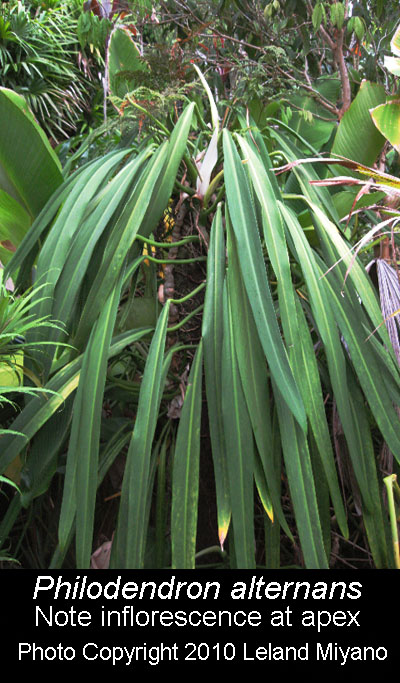 On my Philodendron crassinervium which bloomed a
few months ago this area of emergence is an obscure slit...especially on the
dormant petioles and exhibit no distinct swelling. Only a few of the
many petioles bloomed on any one plant of Philodendron crassinervium.
How taxonomically significant this is I cannot say. I will have to wait
until my plants bloom and then I can compare fertile details directly.
Perhaps some of the botanists with plants already have inflorescences
photographed to make that comparison. I will wait for fertile material
to be more confident but it is my initial impression that two species are
involved here. Like I stated earlier, they are very different in my
mind...but this needs additional investigation. Here are several
scenarios. 1) Philodendron alternans as it is here may be an extreme form of
Philodendron crassinervium and it is a synonym. 2) Philodendron
alternans may be resurrected from synonymy from Philodendron crassinervium.
3) This so-called Philodendron alternans may prove to be an undescribed
taxon and a new name created."
Please read Leland's additional
information beneath both photographs adjacent to this paragraph.
On my Philodendron crassinervium which bloomed a
few months ago this area of emergence is an obscure slit...especially on the
dormant petioles and exhibit no distinct swelling. Only a few of the
many petioles bloomed on any one plant of Philodendron crassinervium.
How taxonomically significant this is I cannot say. I will have to wait
until my plants bloom and then I can compare fertile details directly.
Perhaps some of the botanists with plants already have inflorescences
photographed to make that comparison. I will wait for fertile material
to be more confident but it is my initial impression that two species are
involved here. Like I stated earlier, they are very different in my
mind...but this needs additional investigation. Here are several
scenarios. 1) Philodendron alternans as it is here may be an extreme form of
Philodendron crassinervium and it is a synonym. 2) Philodendron
alternans may be resurrected from synonymy from Philodendron crassinervium.
3) This so-called Philodendron alternans may prove to be an undescribed
taxon and a new name created."
Please read Leland's additional
information beneath both photographs adjacent to this paragraph.
But then Harry Luther of the Marie Selby Botanical Garden in Sarasota, Florida sent a note saying, "I collected P. crassinervium in 1996 between Mangaritba and Angra dos Reis, Rio de Janerio, Brazil in lowland more or less undisturbed (rare!) Atlantic Forest. I do not believe that it and the P. alternans that I received from Leland are conspecific." Angra dos Reis means "King’s Cove" in Portuguese and is a city approximately 150 km (60 miles) southwest of the city of Rio de Janeiro. The term conspecific indicates the species would be the same, thus the plant Harry received from Leland would not be the same in this case.
Since
natural variation in aroid species is very common but not well
understood by plant collectors once you
complete this
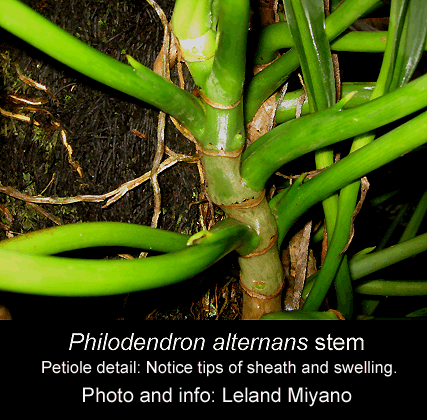 article you may want to read this link on
natural variation within aroid species.
article you may want to read this link on
natural variation within aroid species.
The plant in the majority of our photos (other than the photos by Leland
Miyano) was acquired from the collection of the Missouri Botanical Garden in St. Louis
and was originally identified as Philodendron lanceolatum. The original specimen in the MOBOT collection was acquired as a cultivated
plant collected in Brazil on August 5, 1986 as a part of a mixed collection
which was originally numbered 61933. We do not know if our specimen
(which was a gift) was taken as a cutting from that plant or another specimen in the MOBOT
collection.
The
species characteristic information in this article was extracted from the published field notes of
aroid botanist Dr.
Thomas B. Croat
Ph.D., P.A. Schulze Curator of Botany
of the Missouri
Botanical Garden in St. Louis, MO.
Dr. Croat's notes can be found on the MOBOT
website TROPICOS
http://www.tropicos.org/
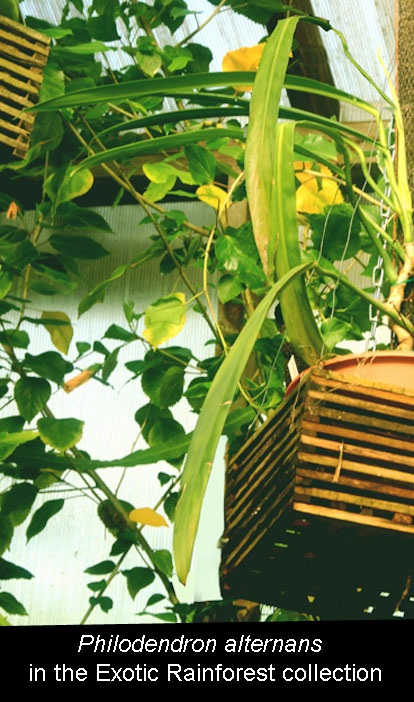 Additional information was used from Anna Haigh's translation of a synopsis
published in 1913 by botanist Kurt Krause which can be found on the Royal
Botanic Garden Kew (London) website CATE Araceae. Anna's translation
can be read near the end of this article.
Additional information was used from Anna Haigh's translation of a synopsis
published in 1913 by botanist Kurt Krause which can be found on the Royal
Botanic Garden Kew (London) website CATE Araceae. Anna's translation
can be read near the end of this article.
http://www.catearaceae.org/index.do;jsessionid=96982249A0181F1EB1E74E6CEB9841D4
All measurements apply to adult plants but the
characteristics described should be evident on sub-adult specimens.
Please do not assume the characteristics can be seen on extremely juvenile specimens.
Just like humans, plants go through natural ontogeny and morphogenesis as they grow.
The photo to the right is of a specimen identified by Dr. Croat as
Philodendron alternans.
Growth in nature
Philodendron crassinervium is often found creeping over rocks as an epipetric plant but the species also grows terrestrially in soil beneath the rain forest canopy. In science Philodendron crassinervium is known as being repent which indicates the rhizomatous stems creep across the soil. A rhizome is a horizontal stem often found underground but in aroids may grow partially above the soil. As is discussed later in this article the stem is not the support for any leaf blade but is instead the central axis of the plant. The species is also a low climber on trees and grows close to the host as a scandent epiphyte. An epiphyte is any plant that grows attached to another plant, normally a tree. An epiphytic species uses the host as a support but is not a parasite and does not draw nourishment from the host.
Blades of Philodendron crassinervium
In
nature the leaf blades of
Philodendron crassinervium vary in both width and length and are normally bright green, are
linear-oblong or lanceolate-oblong and
typically point upwards. In Philodendron alternans the blades
may grow upwards
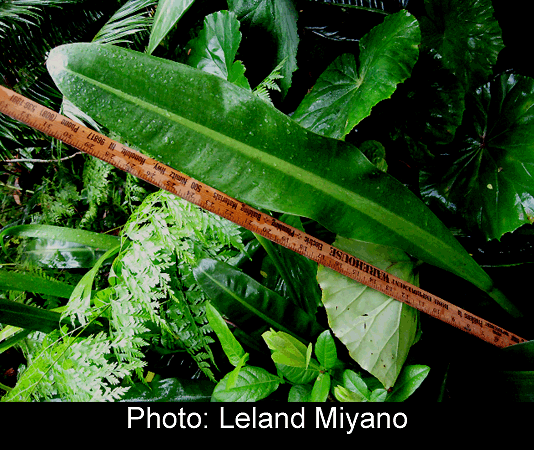 or outwards but are more frequently known to hang
pendently (downwards).
The term lanceolate indicates a blade that
has a long lance shaped
leaf (as in the weapon known as a lance) while linear-oblong indicates a
blade that is both oblong as well as elongated. The blades
may grow to a length of almost one meter (3 feet plus) with a width up to
approximately 10 cm (almost 4 inches). However, some wild and
cultivated specimens have a
shorter overall blade length and are also wider or narrower in their overall width.
The blade at the top of this page measures 73.5 cm or 28.9 inches.
or outwards but are more frequently known to hang
pendently (downwards).
The term lanceolate indicates a blade that
has a long lance shaped
leaf (as in the weapon known as a lance) while linear-oblong indicates a
blade that is both oblong as well as elongated. The blades
may grow to a length of almost one meter (3 feet plus) with a width up to
approximately 10 cm (almost 4 inches). However, some wild and
cultivated specimens have a
shorter overall blade length and are also wider or narrower in their overall width.
The blade at the top of this page measures 73.5 cm or 28.9 inches.
The blades may be a medium to dark green in color as well as semi-glossy on the adaxial (upper) surface but will be somewhat paler as well as moderately matte on the underside (abaxial surface). The leaves of Philodendron crassinervium range from sub-coriaceous to moderately coriaceous and are bicolorous, Coriaceous indicates a leaf blade that feels like leather while the term sub-coriaceous indicates a blade that possesses a feeling of being just less than leathery. Bicolorous indicates a leaf blade that has two different shades or colors.
The
veins on any leaf are divided into classifications which include the midrib,
primary lateral veins, interprimary veins and tertiary or minor veins.
Some species also possess veins known as the basal veins but those are
not seen on
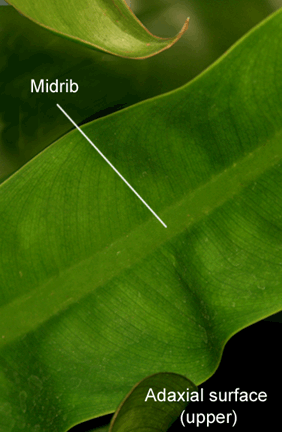 Philodendron crassinervium. The predominant midrib at the
center of any leaf of Philodendron crassinervium is also known as
the mid vein.
Philodendron crassinervium. The predominant midrib at the
center of any leaf of Philodendron crassinervium is also known as
the mid vein.
The apex (tip) of the leaf blade is considered cuspidate-acuminate which means it tapers to a sharp crisp point. The blade is narrowly cuneate (wedge-shaped) with the narrow part at the base having almost straight sides. The base is normally not more than 6 to 10 cm (2.35 to almost 4 inches) wide.
The name Philodendron crassinervium was derived from the Latin words "crassus" which can mean thick or plump and "nervis" which indicates a nerve. The binomial Latin name therefore indicates a Philodendron that possesses a plump or spongy midrib (nerve). The midrib is often swollen and spongy to the touch since it stores water during periods of drought. Despite living in a rain forest seasons of drought commonly occur once the rains cease to fall during the annual dry season. Along the midrib can be observed small red glands that may produce a clear liquid known as guttation. Although sometimes called "sap" on plant discussion websites, guttation is a watery liquid that comes out of the plant and is common in many plant species especially at night. Since evaporation is not "pulling" the water out of the plant as rapidly once the rain forest temperatures cool the backwards water pressure pushing on the stem may build and the plant is forced to release the liquid through the leaves. See "petioles" below for a further explanation.
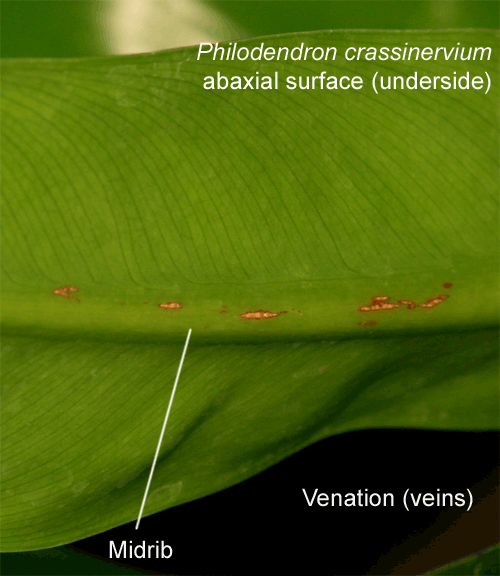 The midrib
is convex on both sides of the blade but is obtusely flat (slightly rounded) near the base
while raised near the center. The midrib is paler on the upper surface
while narrowly rounded on the underside (abaxial surface) as well as densely lineate
(lined) on the upper side while
only sparsely lineate with dark green lines on the underside.
The midrib
is convex on both sides of the blade but is obtusely flat (slightly rounded) near the base
while raised near the center. The midrib is paler on the upper surface
while narrowly rounded on the underside (abaxial surface) as well as densely lineate
(lined) on the upper side while
only sparsely lineate with dark green lines on the underside.
Although the blades of aroids often have obvious venation (veins) the interprimary veins and the tertiary or minor veins are difficult to observe on the blades of Philodendron crassinervium. The primary lateral veins are slender as well as sub-parallel (less than parallel) but are more or less evenly spaced. The veins also spread as they ascend to join near the margin (edge of the blade). As a result the primary lateral veins are obscure and all but absent to the naked eye on both the adaxial and abaxial surfaces. The minor veins run closely spaced, are fine in appearance and only slightly distinct without a good magnifying glass. In the magnified photo (right) they can barely be seen both above and below the midrib. We have included enlarged versions of most of the photographs on this page at the end of this article.
Petioles
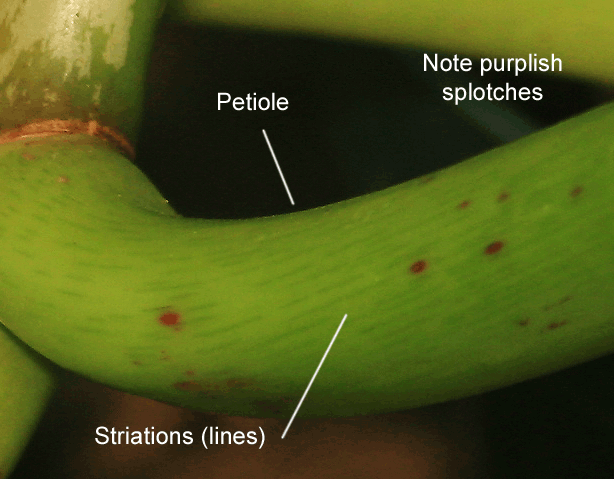 Despite the desire of many growers
to call the
support for any leaf the "stem" that support is not a stem.
The support for the leaves of an aroid are known as petioles. The petiole is
a shoot-like stalk that connects the lamina of the leaf at the petiole's
apex (top) to the specimen's stem which is found growing at the base of the petiole. The
petioles emerge from buds along
the true stem. Their purpose is to support the leaf as well as transfer water and
nutrients though their own cellular structure known as the xylem. The water rises
upwards
using a specialized form of hydraulic pressure that pulls rather than pushes
the water upwards. The upward
pressure on the water is caused by the pull of evaporation as the water
leaves the plant through the blade surface.
Although variations in length are common, the
petioles of Philodendron
crassinervium are
typically 10 to13 cm (almost
4 to just over 5 inches) long as well as 5 to 8 mm (.2 to just over .3
inches) in thickness.
Despite the desire of many growers
to call the
support for any leaf the "stem" that support is not a stem.
The support for the leaves of an aroid are known as petioles. The petiole is
a shoot-like stalk that connects the lamina of the leaf at the petiole's
apex (top) to the specimen's stem which is found growing at the base of the petiole. The
petioles emerge from buds along
the true stem. Their purpose is to support the leaf as well as transfer water and
nutrients though their own cellular structure known as the xylem. The water rises
upwards
using a specialized form of hydraulic pressure that pulls rather than pushes
the water upwards. The upward
pressure on the water is caused by the pull of evaporation as the water
leaves the plant through the blade surface.
Although variations in length are common, the
petioles of Philodendron
crassinervium are
typically 10 to13 cm (almost
4 to just over 5 inches) long as well as 5 to 8 mm (.2 to just over .3
inches) in thickness.
The petioles of Philodendron crassinervium may be moderately firm to
spongy to the touch and are shaped as terete to subterete or
even "C" shaped. The term terete indicates the petiole is roughly round,
subterete indicates slightly flattened on both surfaces and "C" shaped indicates the petiole
looks somewhat like the letter "C" once cut as a cross section.
The petioles may also be slightly flattened only on their upper surface and on
some specimens the petiole's edges may be moderately acute (sharp).
The petioles may have interrupted lines or be finely striated
with dark green as well as possess a purplish speckling. Striate
indicates there are parallel lines running along the petiole's axis.
Cataphylls
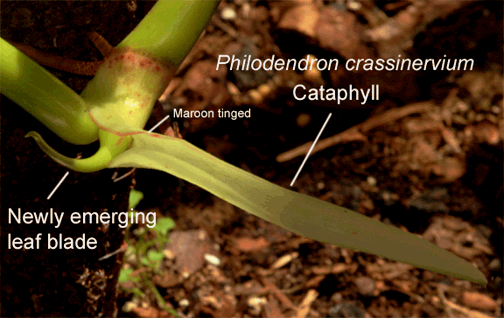 When a new leaf and petiole begin to emerge from a bud
on the stem it is
surrounded by a bract-like modified leaf known as a cataphyll. The
cataphyll serves as a "sheath" and its purpose is to protect the new leaf as it
begins its
development. The cataphylls of Philodendron crassinervium typically
measure in the range of 8 to 20 cm (3.15 to almost 8 inches) long and are light yellow green.
They are either single ribbed or
unribbed and may become twisted as well as reflexed (turn backwards) as
they age.
The petioles are sometimes densely reddish speckled and may be tinged with
maroon. The cataphylls of Philodendron crassinervium persist on the plant for a period of time but
eventually become deciduous and fall from the plant once the blade is fully
mature.
When a new leaf and petiole begin to emerge from a bud
on the stem it is
surrounded by a bract-like modified leaf known as a cataphyll. The
cataphyll serves as a "sheath" and its purpose is to protect the new leaf as it
begins its
development. The cataphylls of Philodendron crassinervium typically
measure in the range of 8 to 20 cm (3.15 to almost 8 inches) long and are light yellow green.
They are either single ribbed or
unribbed and may become twisted as well as reflexed (turn backwards) as
they age.
The petioles are sometimes densely reddish speckled and may be tinged with
maroon. The cataphylls of Philodendron crassinervium persist on the plant for a period of time but
eventually become deciduous and fall from the plant once the blade is fully
mature.
Stems, nodes, internodes and roots of Philodendron crassinverium
"Stem" is one of the most frequently misused terms in the world of plant
collecting since collectors almost always incorrectly refer to the stalk
that supports
any individual leaf as the "stem". The
stem is the support for the
entire plant and is the plant's base, In terrestrial species the
stem is found growing over the ground as a rhizome while in epiphytic species the stem
climbs the host tree to which it is often tightly pressed (appressed).
Although roots normally anchor a
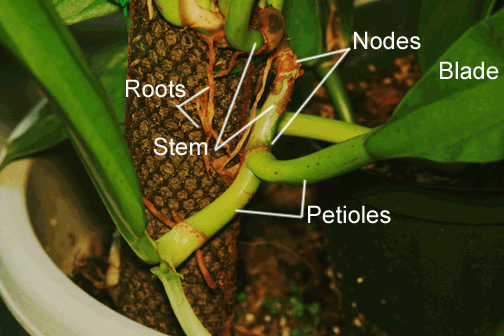 plant to the soil, the stem of an epiphyte is
also held to the tree by the same roots which grow from the nodes found at intervals
along its own length. Those nodes are separated by stem segments which
are called internodes. The nodes also produce
buds which in turn produce the petioles which support the leaves.
plant to the soil, the stem of an epiphyte is
also held to the tree by the same roots which grow from the nodes found at intervals
along its own length. Those nodes are separated by stem segments which
are called internodes. The nodes also produce
buds which in turn produce the petioles which support the leaves.
The stems of Philodendron crassinervium are green and smooth to the touch and typically measure between 7 to 10 cm (2.75 to almost 4 inches) in diameter. In epiphytic specimens they are often pendent and hang downwards as well as climb upwards. The internodes are green to grey green in color and typically measure 3 to 6 cm (1.2 to 1.35 inches) in length and turn brown as they age. The aerial roots of epiphytic specimens are red to reddish brown as they begin growing but later turn a dark brown as they age.
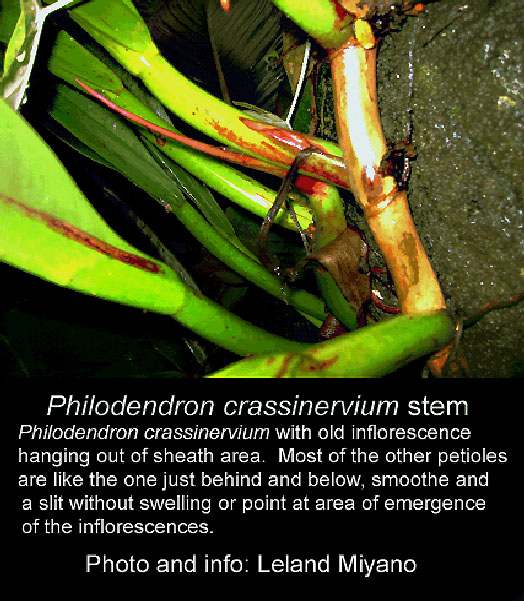
Sexual reproduction
The information regarding the inflorescence of Philodendron crassinervium was taken from a translation of the work of botanist Kurt Krause published in 1913. The entire translation by Anna Haigh can be read at the end of this article.
Philodendron species are members of the larger plant family Araceae (uh-RAY-see ee), commonly known as aroids. An aroid is characterized by the growth of an inflorescence which is the sexual reproductive organ of the plant. The major parts of an inflorescence are known as a spathe and spadix. When an aroid is referred to as "flowering" the reference is truly to the very small flowers which are produced along the spadix and has nothing to do with the spathe itself. The only connection between the two is both the flowers on the spadix and the spathe are produced when the plant is sexually active.
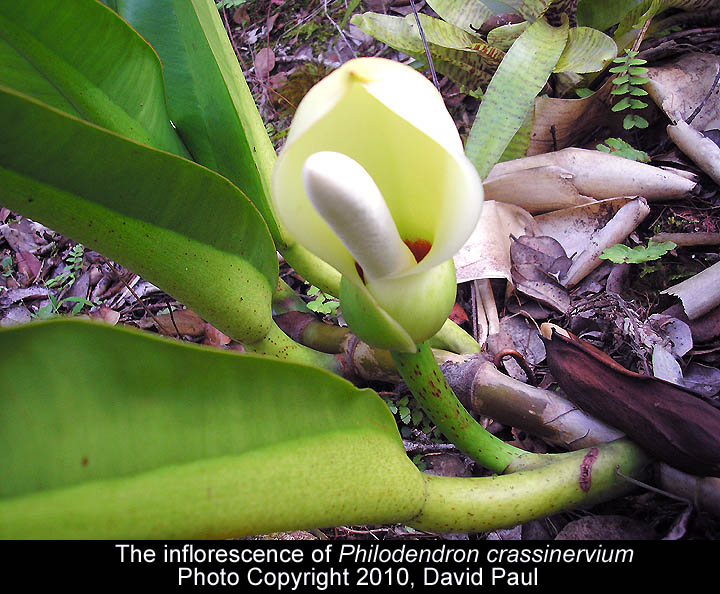
The inflorescence is supported
on a stalk known as the peduncle
which in this species is slender and normally measures between 10 to 15 cm
(almost 4 to 6 inches)
in length. A peduncle is the
internode between the spathe and
the last foliage leaf.
The peduncle may be tinged purple on the apex (top).
The spathe of Philodendron crassinervium is described by K.
Krause as "boat shaped", and is normally white with shades of a dark
red towards the region
where the spadix emerges but may be green on the outside,
Additionally the spathe may be
heavily tinged violet purple toward upper end. The inside
of the spathe is a light purple at the base but is green towards the
spathe's blade which is the upper edge of the spathe.
The spadix of Philodendron crassinervium is stipulate and grows to approximately 20
to 25 cm
(7.8 to 9.8 inches) long. In botany the term stipulate indicates
there is a stipe or additional stalk which slightly separates the spadix
and the spathe.
When ready to
reproduce the spadix of Philodendron crassinervium produces male,
female and sterile flowers which are cleverly divided by
nature in separated zones. Nature separates the zones in
Philodendron
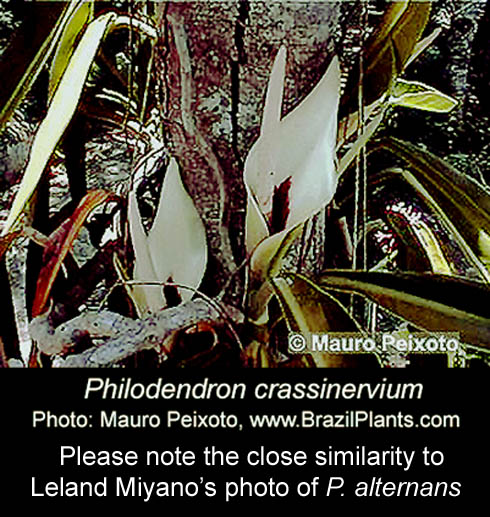 species in order to prevent self
pollination. The female flowers as well as the sterile
male flowers are hidden inside a
covered region at the bottom of the spathe known as the "floral
chamber". The fertile male flowers are exposed on the visible
portion of the spadix just above the floral chamber and when
mature produce pollen. The purpose of the sterile male
flowers is to produce a perfume-like substance known as a pheromone
used to attract pollinating insects. The sterile male flowers also serve
as a source of protein food to those pollinators.
species in order to prevent self
pollination. The female flowers as well as the sterile
male flowers are hidden inside a
covered region at the bottom of the spathe known as the "floral
chamber". The fertile male flowers are exposed on the visible
portion of the spadix just above the floral chamber and when
mature produce pollen. The purpose of the sterile male
flowers is to produce a perfume-like substance known as a pheromone
used to attract pollinating insects. The sterile male flowers also serve
as a source of protein food to those pollinators.
Philodendron species produce the female flowers on the first evening of anthesis and are no longer receptive by the time the male flowers begin to produce pollen on the second (possibly the third) evening. If the female flowers are pollinated with the pollen of the same species carried by an appropriate beetle in the genus Cyclocephala from another specimen they will eventually produce berries containing seeds. The oblong berries (fruits) are white and once mature normally contain 2 seeds. The berries are described as being turbinate or obconical and measure 4 to 5 mm (.16 to .20 inches) long as well as 2 mm (.08 inches) thick, Turbinate and obconical indicate a shape similar to the top of a cone that is pointed.
To
further add to the confusion over whether or not Philodendron alternans
Schott as well as Philodendron lanceolatum
Schott
are one and the same as
Philodendron
crassinervium Dr. Croat provided a copy of Schott's painted plate of the
inflorescence of the plant he described. The variations in color and
shape can easily be a result of natural variation since neither all the leaf
blades nor the inflorescences of aroid species must be an exact match from
specimen to specimen. Color is also not a definitive characteristic. Just
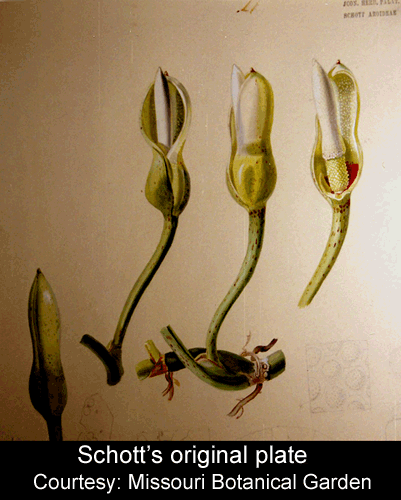 as humans have different colors of skin,
hair, and eyes plants are variable. Whether or not these are
synonyms or truly unique species remains a subject for qualified botanists to determine.
Marcus sent a note in regard to the inflorescence in Mauro's photo which
stated,
"The inflorescence is similar to P. glaziovii, another species that
occurs in Rio de Janeiro."
Leland followed Marcus' note with
"Philodendron glaziovii as identified by Marcus Nadruz has very short
peduncles as compared with the photo and print of the peduncles of the
inflorescences of Philodendron crassinervium."
as humans have different colors of skin,
hair, and eyes plants are variable. Whether or not these are
synonyms or truly unique species remains a subject for qualified botanists to determine.
Marcus sent a note in regard to the inflorescence in Mauro's photo which
stated,
"The inflorescence is similar to P. glaziovii, another species that
occurs in Rio de Janeiro."
Leland followed Marcus' note with
"Philodendron glaziovii as identified by Marcus Nadruz has very short
peduncles as compared with the photo and print of the peduncles of the
inflorescences of Philodendron crassinervium."
Leland did add these observations, "I have taken another closer look at Marcus Nadruz' photos of Philodendron lanceolatum, and this also looks different to me from Philodendron crassinervium. I am only relying on those small photos, so these may be artifacts of the photograph quality, but this is what I notice. First of all the inflorescence is not hooded or cucullate as the original description mentions. The color of the inflorescence differs, although how taxonomically significant this is varies. Second, it appears the primary lateral veins of the Philodendron lanceolatum are prominent. Thirdly, and this is the difficult thing to confirm from a small image, is the petioles appear to be adaxially sulcate, with a sharp edge...this would make the petiole "C" shaped. I could be wrong, but, this is what I am seeing. If I am correct perhaps Philodendron lanceolatum may be resurrected from synonymy from Philodendron crassinervium. Remember, I do not have any specimens to directly observe so some of these details may be optical illusions."
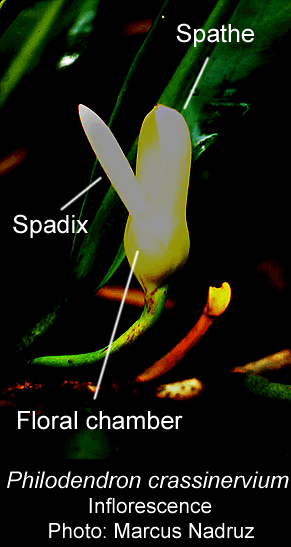 If you compare the plate
at the right to both Mauro and Marcus' photos above and below which somewhat match Anna's translation
found on CATE Araceae the confusion over
whether the species discussed are or are not synonyms would appear to deepen.
But perhaps not. Anna responded to my query
"My
translation as you know is just from the literature cited, not referring to
current material and the current species concept. I only know this species
from sterile material in the field so cannot comment on the appearance of
the inflorescence. However, I think that the Krause description does
pretty well match the Schott plate featured in your web page. Is it
the term "boat-shaped" that you have issue with? Perhaps Tom Croat uses this
term differently from Krause in 1913?"
Mauro's
photo was verified by Dr. Eduardo Gonçalves and
Marcus is a qualified aroid botanist but in the case of Mauro's photo there
appears to be a difference of opinion.
If you compare the plate
at the right to both Mauro and Marcus' photos above and below which somewhat match Anna's translation
found on CATE Araceae the confusion over
whether the species discussed are or are not synonyms would appear to deepen.
But perhaps not. Anna responded to my query
"My
translation as you know is just from the literature cited, not referring to
current material and the current species concept. I only know this species
from sterile material in the field so cannot comment on the appearance of
the inflorescence. However, I think that the Krause description does
pretty well match the Schott plate featured in your web page. Is it
the term "boat-shaped" that you have issue with? Perhaps Tom Croat uses this
term differently from Krause in 1913?"
Mauro's
photo was verified by Dr. Eduardo Gonçalves and
Marcus is a qualified aroid botanist but in the case of Mauro's photo there
appears to be a difference of opinion.
Leland again added one more important
observation, "Philodendron lanceolatum
as grown by Rio Botanical Gardens is organized as a rosette, versus the
linear stem architecture of Philodendron crassinervium. This is a
significant difference. Now this could also be an aberrant
growth due to culture but if it is a normal trait of Philodendron
lanceolatum it would point to separation from synonymy."
My thanks to Mauro Peixoto
www.BrazilPlants.com for the use of his photograph and to aroid, palm
and cycad expert Leland Miyano for his input and photos.
A special thanks to aroid botanists Dr. Tom Croat, Dr. Eduardo G. Gonçalves, Curador Botânico (botanical curator) of Inhotim in Brazil, Dr. Marcus A. Nadruz Coelho, Diretoria de Pesquisas, Instituto de Pesquisas Jardim Botanico do Rio de Janeiro (Rio de Janeiro Botanical Garden), botanist Dr. David Scherberich of the Jardin Botanique de la Ville de Lyon, Parc de la Tete d' Or, France, botanist David Paul as well as Dr. Simon Mayo and Anna Haigh at the Royal Botanic Garden Kew in London for their assistance.
Below is the original description with the plate of Philodendron crassinervium made by Lindley and published in the Botanical Register. These were provided by David Scherberich and he indicated the following in his note, "The pictures you have from Mauro Peixoto (inflorescence with unconstricted spathe) certainly represents a different taxon." In fact, Mauro's photo closely resembles Leland's photo of Philodendron alternans.
Since this discussion continues this page is far from complete. Please check back. Several of the individuals involved in this discussion hope to learn more about what appears to be discrepancies in some of the photos that appear on this page.
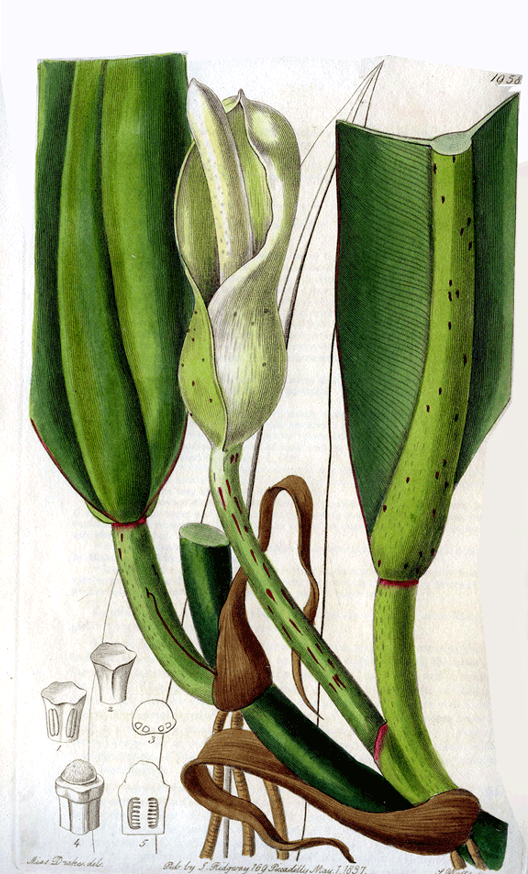
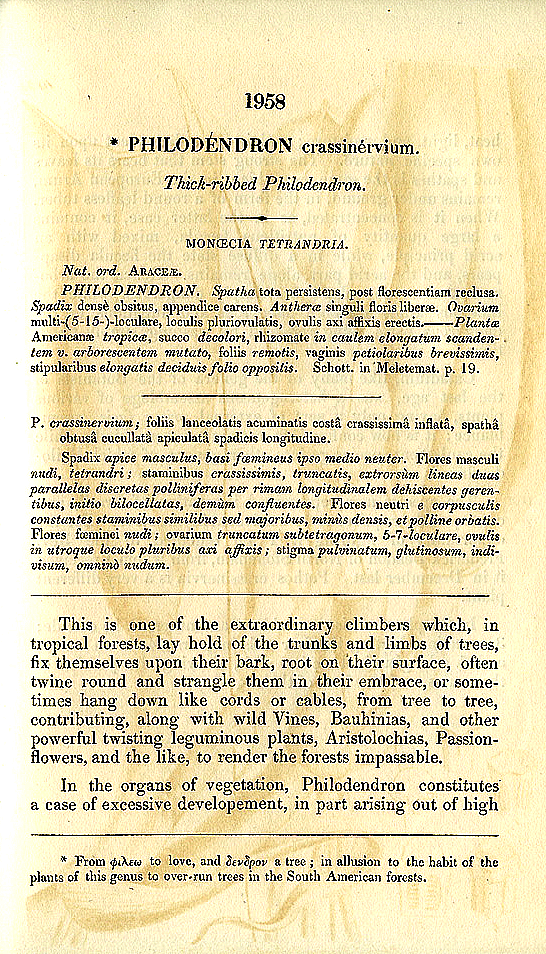
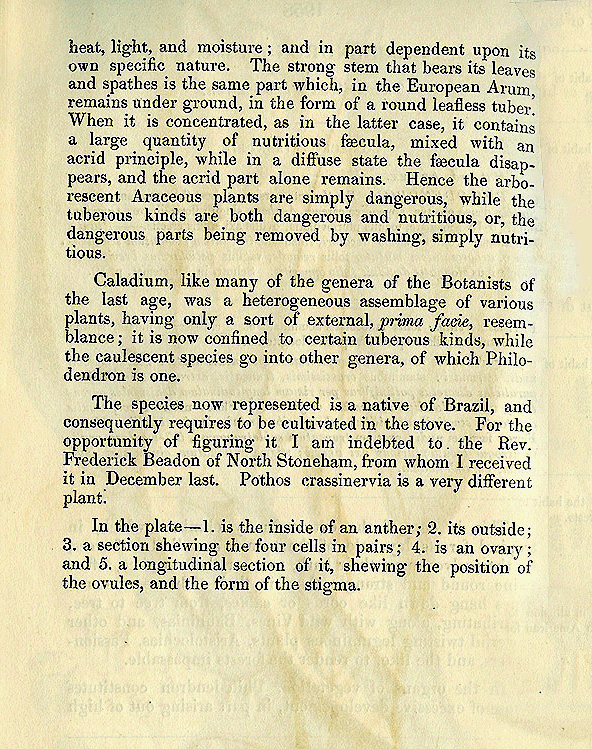
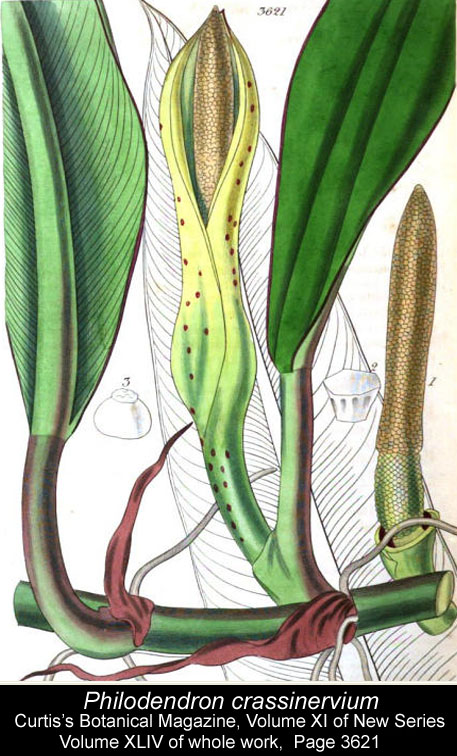
For those with an interest in botanical science this synopsis was extracted from the Royal Botanic Garden Kew website CATE Araceae
Philodendron
crassinervium Lindl. sec CATE Araceae, 2009
Stem repent and scandent, internodes 5-10 cm long, 1.5-2 cm thick.
LEAVES: Petiole semiterete, 10-13 cm long, 5-8 mm thick, sheathed at the
base for 2-3 cm; Blade linear-oblong, or lanceolate-oblong, apex
cuspidate-acuminate for almost 1 cm, narrowly cuneate towards the base,
3-4.5 cm, rarely longer, 6-10 cm wide; midrib swollen, ca. 1 cm wide at the
base, strongly attenuating towards the apex; lateral veins slender,
subparallel, spreading, ascending and joining near the margin.
INFLORESCENCES: Peduncle slender, 10-15 cm long, 3-4 mm thick. Spathe
boat-shaped, apex shortly apiculate, tube 3-4 cm long, externally green,
internally at the base light purple, green-coloured towards the
spathe-blade; spadix shortly stipitate; female zone 5-6 cm long, 1 cm thick.
Pistils ovoid, ca. 2 mm long, 4-6-locular, locules many-ovulate. Male
flowers usually triandrous. Berries turbinate [obconical], 4-5 mm long, 2 mm
thick, white, stigma brown with 4-6 small lobes. Seeds oblong, pale.
Krause, K. 1913. Araceae-Philodendroideae-Philodendreae-Philodendrinae. Das
Pflanzenreich. 60 (IV.23Db): 1-143 p. 22, translated by A. Haigh.
Want to learn more
about aroids?
Join the
International Aroid Society:
http://www.exoticrainforest.com/Join%20IAS.html
Enlarged versions of some of the photos above can be seen below.
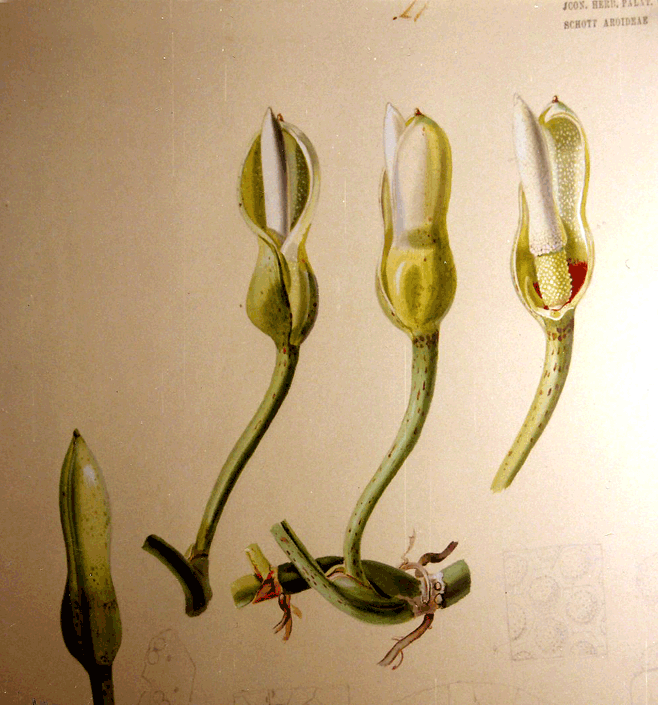
Above: Philodendron crassinervium plate by Schott
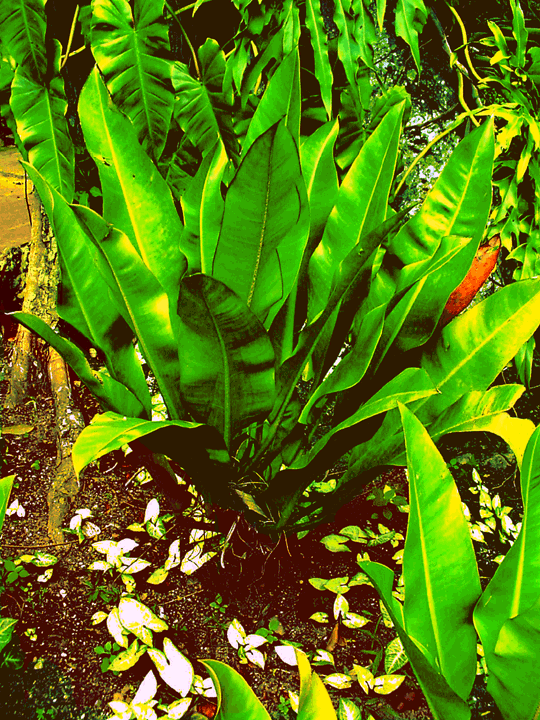
Above: wild Philodendron lanceolatum in soil, Photo by Marcus Nadruz
All photos below are of the specimen
of Philodendron lanceolatum acquired from
the Missouri Botanical Garden mentioned in this article.
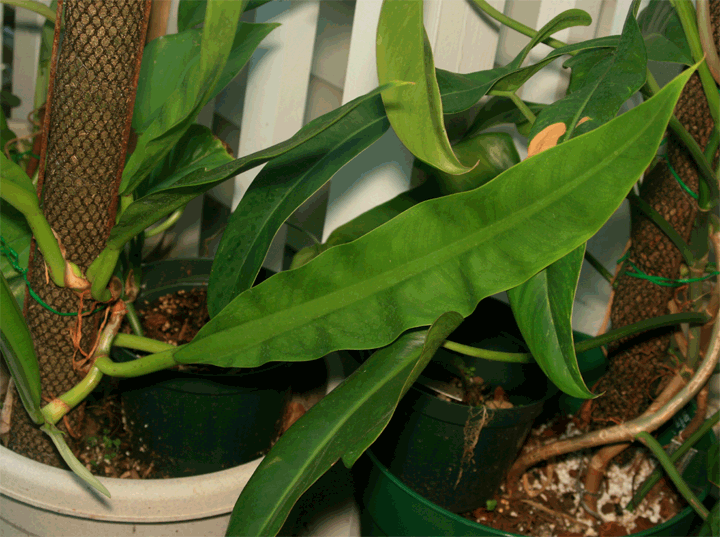
Adaxial venation
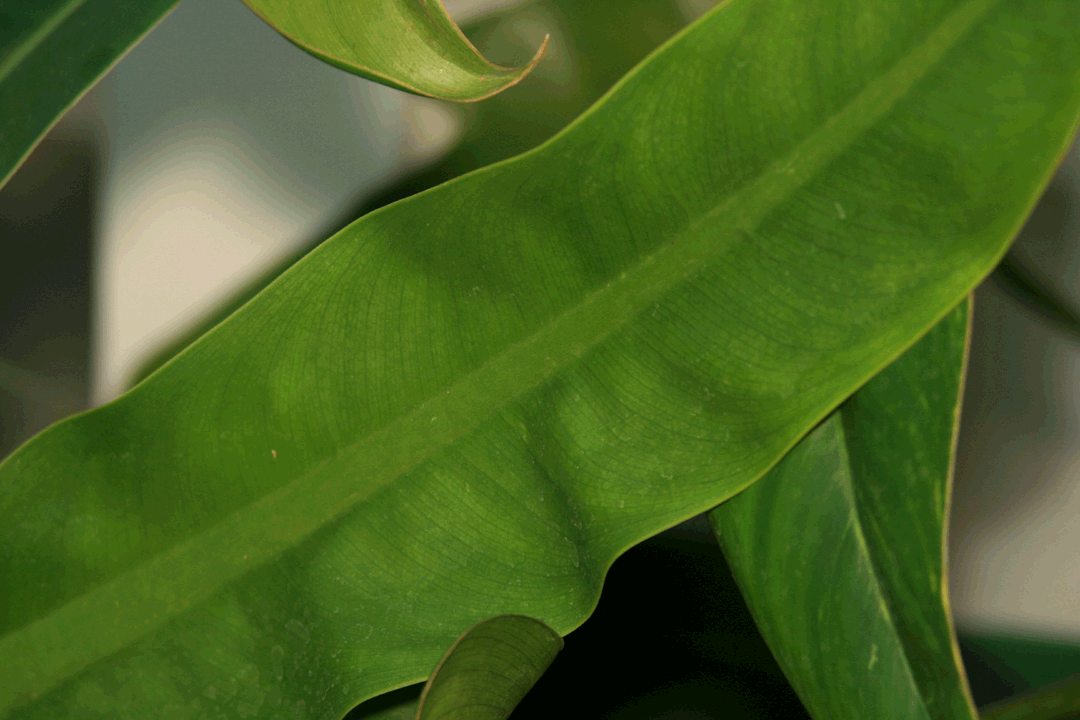
Adaxial venation closer
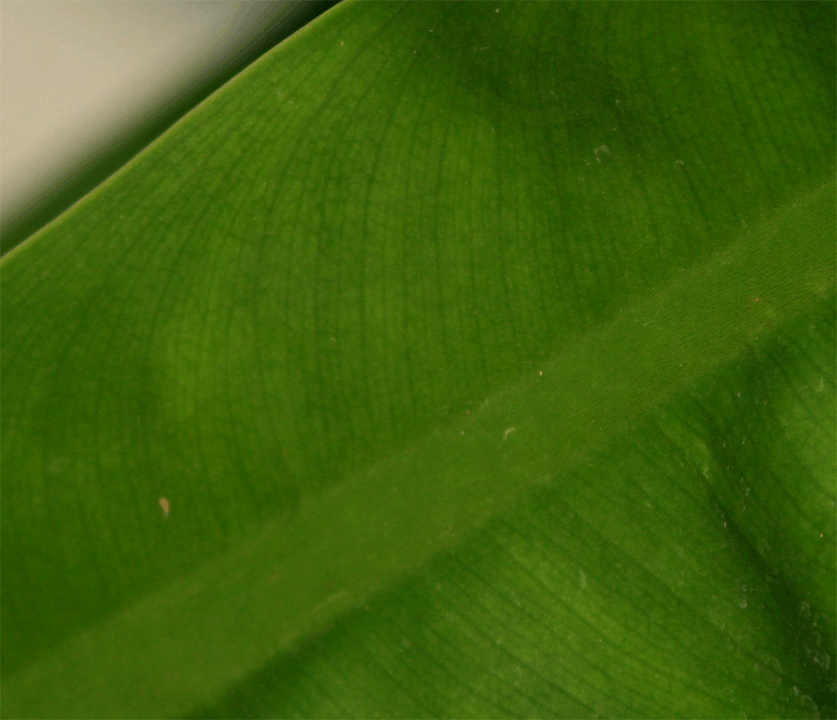
Abaxial midrib
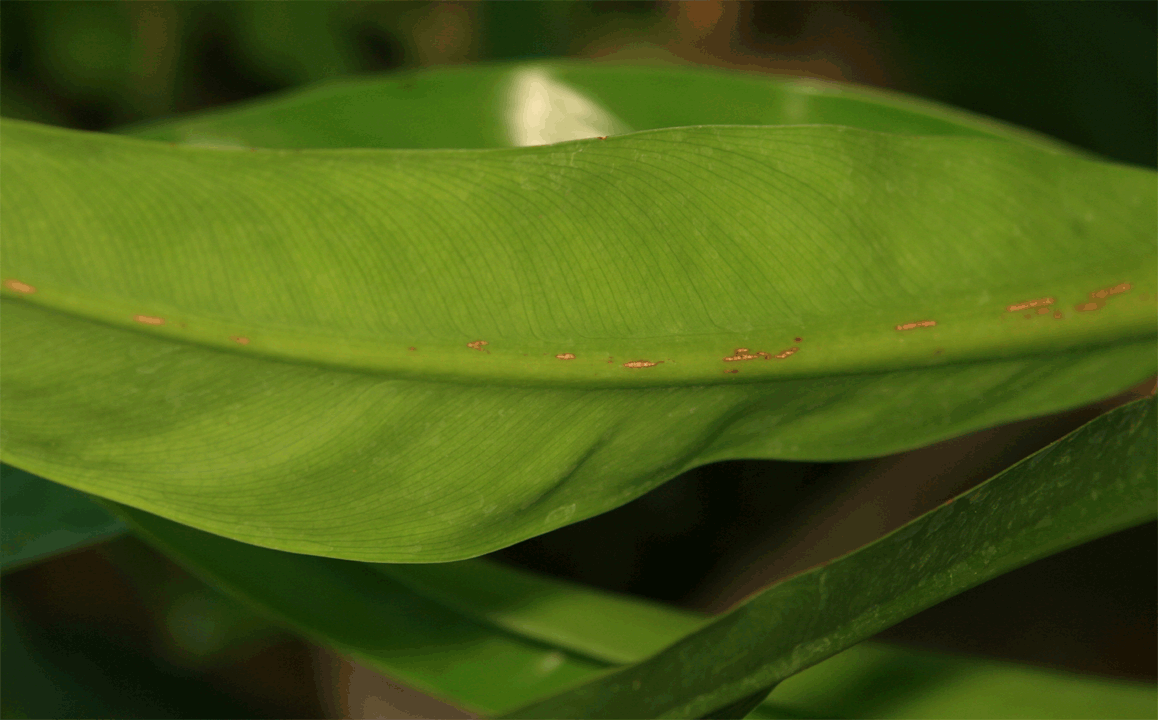
Abaxial midrib and venation closer
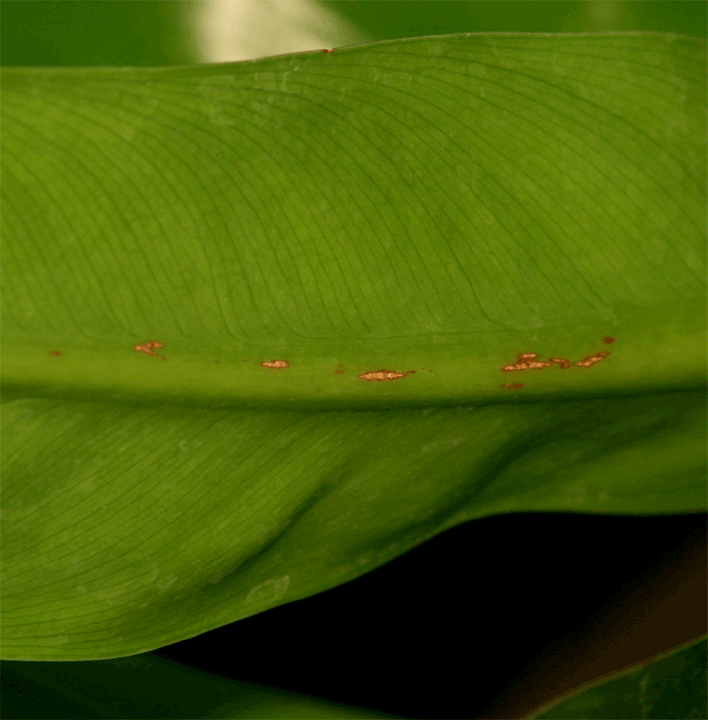
Midrib flattened at base
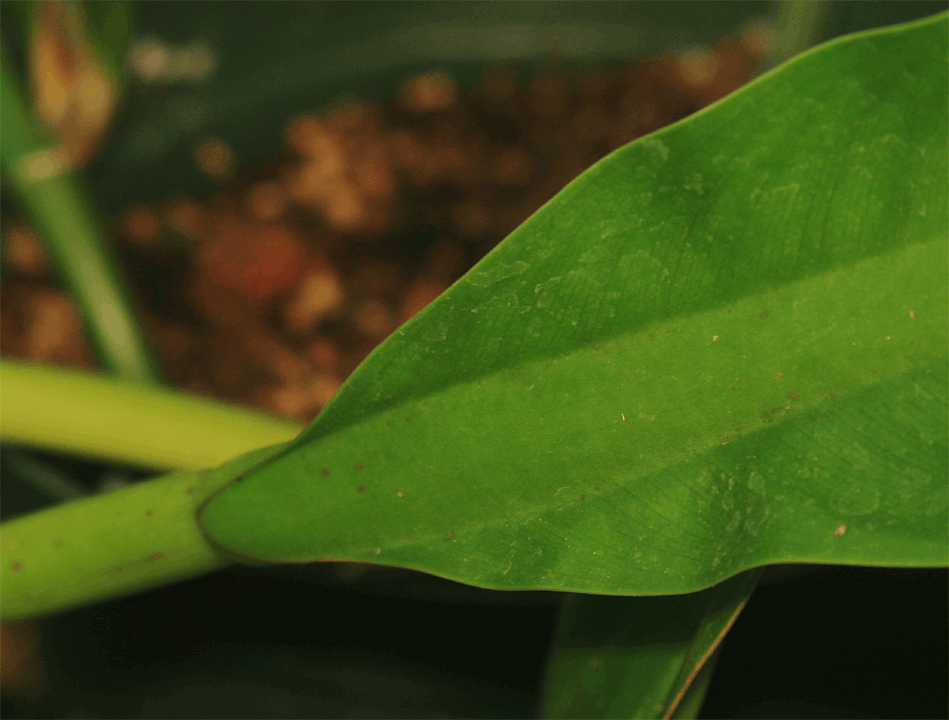
Petiole striated, purplish speckled
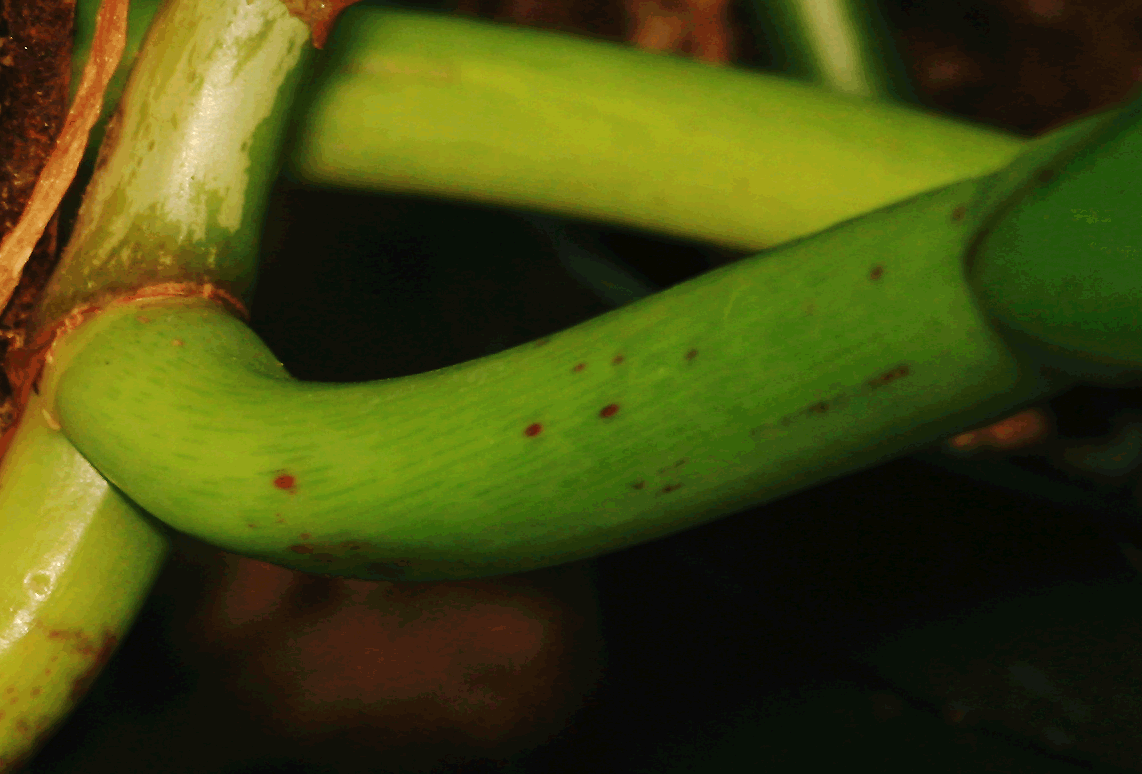
Stem
